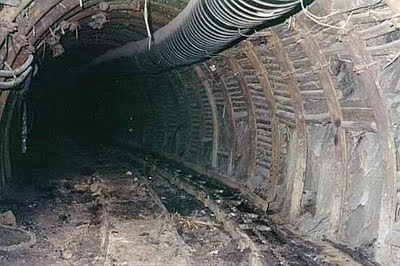 Las galerías de las minas que están a punto de cerrar se pueden aprovechar para que los municipios del entorno obtengan energía geotérmica. Ésta es la conclusión de dos ingenieros de la Universidad de Oviedo, que este mes publican su investigación en la revista Renewable Energy. El método que han desarrollado permite estimar la cantidad de calor que podría aportar una galería.
Las galerías de las minas que están a punto de cerrar se pueden aprovechar para que los municipios del entorno obtengan energía geotérmica. Ésta es la conclusión de dos ingenieros de la Universidad de Oviedo, que este mes publican su investigación en la revista Renewable Energy. El método que han desarrollado permite estimar la cantidad de calor que podría aportar una galería.“Una forma de aprovechamiento de la energía geotérmica de baja intensidad es convertir las galerías de las minas en calderas geotérmicas, que podrían facilitar calefacción y agua caliente a los vecinos del entorno”, explica a SINC Rafael Rodríguez, de la Escuela Técnica Superior de Ingenieros de Minas de Oviedo. Este tipo de energía, que apenas se aprovecha en España, se obtiene a partir del calor del interior de la Tierra.
El ingeniero, junto a su colega María Belarmina Díaz, han desarrollado un método “semi-empírico” (entre matemático y experimental) para calcular la cantidad de calor que podrían proporcionar una galería de una mina que se va a abandonar, a partir de estudios realizados mientras todavía está activa.
El uso de la energía geotérmica también permite reducir las emisiones de CO2 y es independiente de las condiciones climáticas (a diferencia de otras energías renovables como la solar o la eólica). Otras ventajas son que sus instalaciones utilizan recursos propios de un país, no requieren grandes extensiones de terreno, no contaminan el entorno próximo y están consideradas rentables a largo plazo.
La energía geotérmica se puede usar directamente en viviendas unifamiliares, urbanizaciones, piscinas, piscifactorías, naves industriales y otros edificios.
 Mine shafts on the point of being closed down could be used to provide geothermal energy to local towns. This is the conclusion of two engineers from the University of Oviedo (Spain), whose research is being published in the journal Renewable Energy. The method they have developed makes it possible to estimate the amount of heat that a tunnel could potentially provide.
Mine shafts on the point of being closed down could be used to provide geothermal energy to local towns. This is the conclusion of two engineers from the University of Oviedo (Spain), whose research is being published in the journal Renewable Energy. The method they have developed makes it possible to estimate the amount of heat that a tunnel could potentially provide."One way of making use of low-intensity geothermal energy is to convert mine shafts into geothermal boilers, which could provide heating and hot water for people living nearby", Rafael Rodríguez, from the Oviedo Higher Technical School of Mining Engineering, tells SINC. This type of energy, which is hardly used in Spain, is obtained from the internal heat of the Earth.
The engineer and his colleague María Belarmina Díaz have developed a "semi-empirical" method (part mathematical and part experimental) to calculate the amount of heat that could be produced by a mine tunnel that is due to be abandoned, based on studies carried out while it is still in use.
Using geothermal energy also helps to reduce CO2 emissions, and is not dependent upon climatic conditions (unlike other renewable energies such as solar or wind power). Other advantages are that these facilities make use of a country's own resources, do not require new developments on large sites, do not pollute the immediate environment, and are believed to be profitable over the long term.
Geothermal energy can be used directly in family homes, housing developments, swimming pools, fish farms, industrial units and other buildings.
Tomado de/Taken from Plataforma SINC/Science Daily
Resumen de la publicación/Abstract of the paper
Analysis of the utilization of mine galleries as geothermal heat exchangers by means a semi-empirical prediction method
Rafael Rodríguez and María B. Díaz, Renewable Energy, 34(7) 1716-1725 (2009)
Abstract
The use of renewable energies in Spain is growing; nevertheless, up to now, a very low use of geothermal energy is found. In this paper, the use of low enthalpy geothermal energy that consists of converting mine galleries in underground heat exchangers is described and analysed. The system would be used in those areas with mining works that with a near future closure, such as Asturias but also other regions of Spain or Europe. The described system, unlike other proposed ones, implies to act before the closure of the mines, when it is possible to access underground galleries. A prediction method for evaluating the system capabilities has been developed which has been calibrated with measurements taken in underground mines and which can be used and calibrated in any mine in operation. Finally, using the method, the capabilities of a typical system are analysed and its viavility from a technical, economic and environmental point of view is proved.
No hay comentarios:
Publicar un comentario